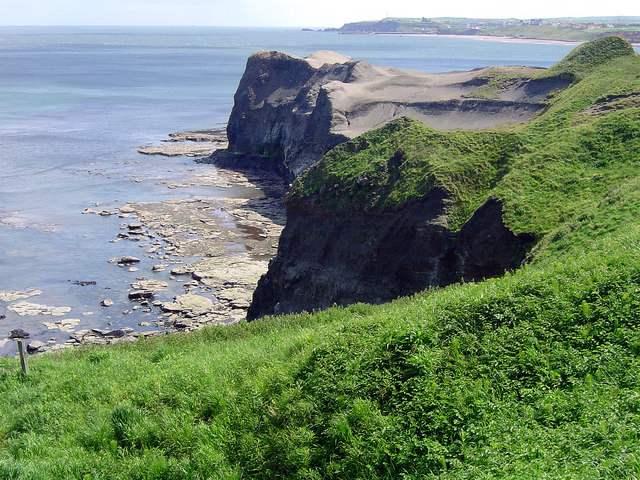Sandsend Ness on:
[Wikipedia]
[Google]
[Amazon]
 Sandsend Ness is an old
Sandsend Ness is an old
Effects of Alum Quarrying on the Yorkshire Coast
Quarries in North Yorkshire Whitby {{Scarborough-geo-stub
 Sandsend Ness is an old
Sandsend Ness is an old alum
An alum () is a type of chemical compound, usually a hydrated double sulfate salt of aluminium with the general formula , where is a monovalent cation such as potassium or ammonium. By itself, "alum" often refers to potassium alum, with t ...
quarrying site close to Whitby
Whitby is a seaside town, port and civil parish in the Scarborough borough of North Yorkshire, England. Situated on the east coast of Yorkshire at the mouth of the River Esk, Whitby has a maritime, mineral and tourist heritage. Its East Clif ...
in North Yorkshire
North Yorkshire is the largest ceremonial county (lieutenancy area) in England, covering an area of . Around 40% of the county is covered by national parks, including most of the Yorkshire Dales and the North York Moors. It is one of four cou ...
, England
England is a country that is part of the United Kingdom. It shares land borders with Wales to its west and Scotland to its north. The Irish Sea lies northwest and the Celtic Sea to the southwest. It is separated from continental Europe ...
.
Beneath extensive deposits of grey pyritic shale
Shale is a fine-grained, clastic sedimentary rock formed from mud that is a mix of flakes of clay minerals (hydrous aluminium phyllosilicates, e.g. kaolin, Al2 Si2 O5( OH)4) and tiny fragments (silt-sized particles) of other minerals, especia ...
a thin band of sideritic mudstone is present at this site and there is a further 6 metres of almost non-bituminous shale beneath it. This geological configuration, along with its proximity to the port of Whitby, offered Sandsend near-ideal conditions for the rapidly expanding alum industry from the early 17th century onwards.
So wide-scale and prolonged were these activities, that significant areas of the Yorkshire coast were permanently altered.
The double sulphate of aluminium and either potassium or ammonia is commonly known as alum. This material was of great importance through to the late 19th century in leather tanning and in the wool dying industry. Even today it is still used in some places as a mordant
A mordant or dye fixative is a substance used to set (i.e. bind) dyes on fabrics by forming a coordination complex with the dye, which then attaches to the fabric (or tissue). It may be used for dyeing fabrics or for intensifying stains in ...
(dye fixative).
Fossil
A fossil (from Classical Latin , ) is any preserved remains, impression, or trace of any once-living thing from a past geological age. Examples include bones, shells, exoskeletons, stone imprints of animals or microbes, objects preserved ...
s are present in large numbers in the deposits, including ammonite
Ammonoids are a group of extinct marine mollusc animals in the subclass Ammonoidea of the class Cephalopoda. These molluscs, commonly referred to as ammonites, are more closely related to living coleoids (i.e., octopuses, squid and cuttle ...
s such as ''Hildoceras bifrons
''Hildoceras bifrons'' is an extinct species of ammonite in the family Hildoceratidae. It dates from about 175 million years ago in the Early Jurassic when it was both widespread and common. Fossils have been found in North Africa and Europe, in ...
'' and ''Dactylioceras
''Dactylioceras'' was a widespread genus of ammonites from the Lower Jurassic period, approximately 180 million years ago (mya).
Etymology
The name ''Dactylioceras'' comes from the Greek ''dactyl'', meaning “finger”, and refers to the shell ...
bifrons'' and also Ichthyosaur
Ichthyosaurs (Ancient Greek for "fish lizard" – and ) are large extinct marine reptiles. Ichthyosaurs belong to the order known as Ichthyosauria or Ichthyopterygia ('fish flippers' – a designation introduced by Sir Richard Owen in 1842, altho ...
and Plesiosaur remains, though the latter are nowadays much less commonly found. In fact, the ammonite '' Hildoceras'' is named after an early Christian
Christians () are people who follow or adhere to Christianity, a monotheistic Abrahamic religion based on the life and teachings of Jesus Christ. The words '' Christ'' and ''Christian'' derive from the Koine Greek title ''Christós'' (Χρ ...
saint, the Abbess of Whitby St. Hild or Hilda (614-680). It was believed that such ammonite fossils were the snakes which had been miraculously turned into stone by St. Hilda. It was not unknown for local “artisans” to carve snakes' heads onto ammonites, and sell these “relics” as proof of the miracle. The coat of arms of nearby Whitby actually include three such 'snakestones'.
External links
Effects of Alum Quarrying on the Yorkshire Coast
Quarries in North Yorkshire Whitby {{Scarborough-geo-stub